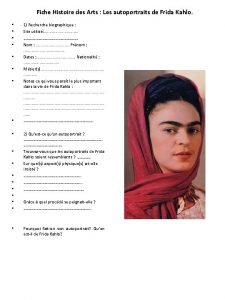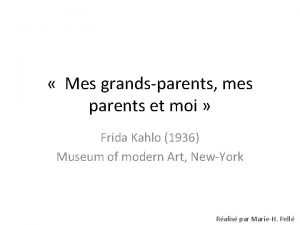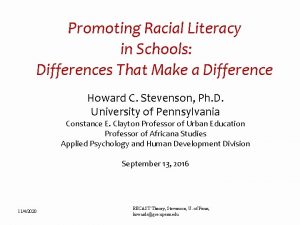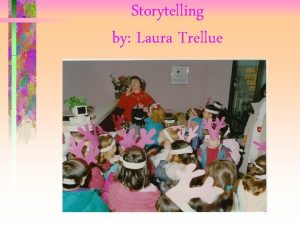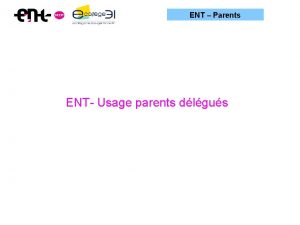Storytelling A presentation for parents 15102014 Promoting Storytelling














- Slides: 14

Storytelling A presentation for parents 15/10/2014

Promoting Storytelling ‘Speaking, listening and thinking skills are vital tools for learning. Without them, we cannot learn effectively’ (Ros Bayley, eye, May 2009)

The Importance of Speaking and Listening Children learn to listen by being listened to. They learn to talk by talking. Children need to be good speakers and listeners before they can become good story tellers, readers and writers. Children need to understand that events need to be sequenced in a logical order, they need to learn to order their ideas and thoughts. Without the essential skills in speaking, listening and understanding, working and playing with others is very difficult. Children need adults who are genuinely interested in listening to what they have to say and talk with them about their thoughts, feelings and ideas. Story telling is an ancient art and highly valued in many cultures. It connects us with our past and gives us identity and purpose. It connects us to our family and community.

Development of Imagination Storytelling is a great way of engaging with young children. When children listen to stories, they respond by creating images of the characters and places described by the words. This process of developing internal images and meaning in response to words is the basis of imagination. Children need interesting things to talk about; things that capture their curiosity and fire their imaginations.

Brain development and story telling The repeated exposure to stories and the subsequent triggering of mental images stimulates appropriate neural development in the brain. It is the reason that children will insist on hearing the same story again and again. Researchers who study brain and behavioural development have identified imagination, not only as the essence of creativity, but as the basis for all higher order thinking. With imagination, with the ability to understand symbols, create solutions, and find meaning in ideas, young people are more capable of mastering language, writing, mathematics, and other learnings that are grounded in the use of symbols

Why should we tell stories? Development Storytelling is crucial in a child’s development. We live our lives through narrative and the earlier we can start, the better Communication Storytelling opens up channels of communication and stimulates emotional, imaginative and linguistic development. It encourages participation and develops confidence and a sense of selfesteem Language Storytelling surrounds the child with imaginative language, introduces unfamiliar words in a narrative context, introduces narrative structure and allows children to give voice to their own ideas in their own language using and promoting creativity Concentration Storytelling develops concentration and listening skills

Improvement of Reading, Writing , and Speaking Skills § Children who listen to stories are exposed to many new words. They may not know what all the words mean, but hearing or reading a story helps them to understand the meaning of the words through context. By developing vocabulary lists based upon the story, the teacher takes advantage of children's natural curiosity to understand the story, and children are motivated to use the new words in stories of their own creation. § Storytelling can promote writing skills by encouraging young people to write their own stories, impressions of stories that they have heard or even a play based upon a familiar tale. Children who hear stories often improve their reading skills because they are interested in reading other . related stories and information

Strengthening of Critical Thinking Skills Traditional stories from throughout the world address many difficult issues of life; they teach how to face adversity and move through it. A close look at traditional stories from any culture reveals stories dealing with death, loss, separation, abandonment, fear, and anger. The stories also show that love, compassion, understanding, and courage can be a part of stories as well. Students grapple with painful realities of life: parental divorce, poverty, substance abuse, the violent deaths of close friends--and stories can help them negotiate these difficulties of life and can be of inestimable value. Stories are also effective in increasing tolerance and understanding of people from other cultures. Through the medium of story, the listener can safely explore what all human beings have in common as well as how they differ from each other.

Storytelling and reading Through participation in storytelling experiences, children learn to build a sense of story by anticipating how a story may begin and end The development of a sense of story allows students to make better predictions, to anticipate what is next, to increase awareness of cause and effect, sequence events, and develop other skills that aid comprehension Some researchers have focused on the practical application of storytelling as a pedagogical strategy to build reading comprehension Storytelling, when modelled properly, can serve as an effective technique for developing literacy and reading comprehension skills.

Telling Stories § There really is a difference between reading a story and telling a story. § Having permanent eye-contact with an audience creates a bond and togetherness and a concentration on the story itself § If you have only ever read stories to children, then try telling a story and notice the difference

Techniques for learning a story to tell § If you are used to reading, but not telling stories, try the following: § Read a story through but visualise it really strongly. You need to have a mental picture of the story as though it is a film, not words on a page. You are simply going to narrate that ‘film’, not learn a script. § Use props to engage children’s attention but make sure that they don’t spoil the story. § Tell a traditional tale that you heard as a child or tell a story about yourself as a child

Using props choose a simple story you are familiar with collect items that are related to your story (e. g. three bears and a dolly for Goldilocks and the three bears ) make your own props to retell or create your own stories sock puppets, finger puppets, pictures on a stick, paper mache masks , and many more…

Pie Corbett and Vivian Gussin Paley § Pie Corbett, educationalist and author, is wellknown for his books on using talk to teach creative writing. § Vivian Gussin Paley is an American pre-school and kindergarten teacher and early childhood education researcher, who strongly beliefs in the power of story telling. She came to Brent in 2008 to train EYFS practitioners in the art of story telling – story acting.

Suggestions from Pie Corbett and Vivian Gussin Paley § A demonstration of storytelling Vivian Gussin Paley style with story words suggested by Pie Corbett
 Parents parents
Parents parents Histoire des arts frida kahlo
Histoire des arts frida kahlo L'arbre généalogique de frida kahlo
L'arbre généalogique de frida kahlo Promote service arrange decide
Promote service arrange decide Health promoting school
Health promoting school Promoting services and educating customers
Promoting services and educating customers Lesson 4 promoting health and wellness
Lesson 4 promoting health and wellness Unit 11 safeguarding adults and promoting independence
Unit 11 safeguarding adults and promoting independence Chapter 7 promoting health and wellness
Chapter 7 promoting health and wellness Promoting infant health section 7-2
Promoting infant health section 7-2 Promoting alternative thinking strategies
Promoting alternative thinking strategies Japan's principal asset in promoting development is
Japan's principal asset in promoting development is Health promoting schools model
Health promoting schools model Promoting racial literacy in schools
Promoting racial literacy in schools Need of national integration
Need of national integration

